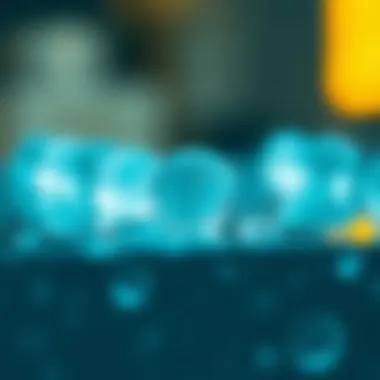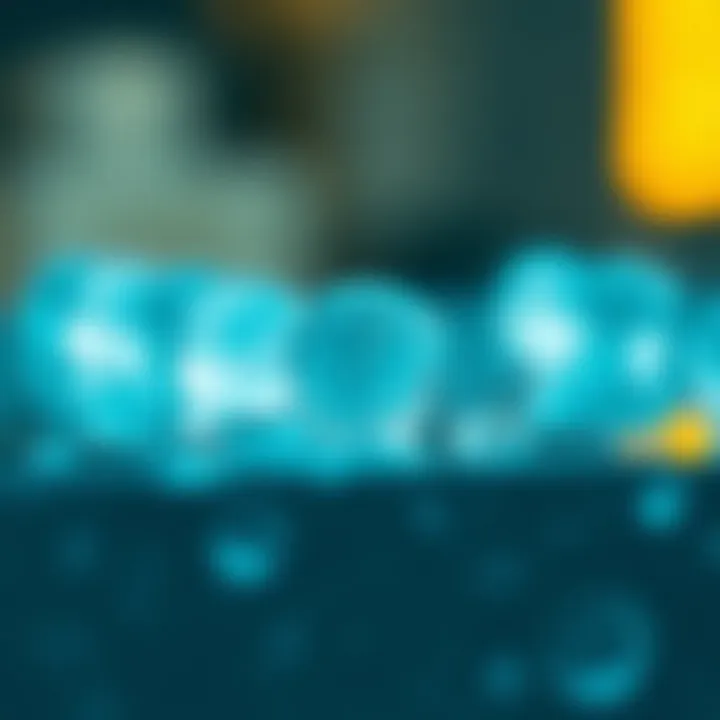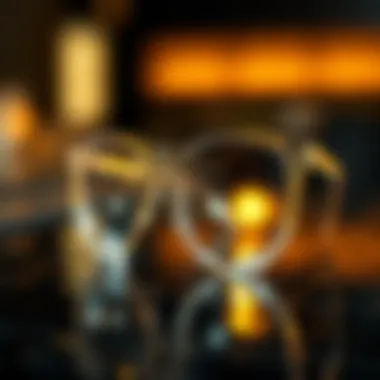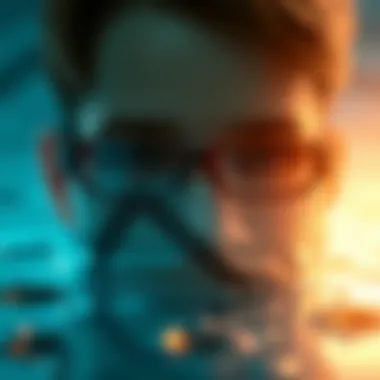Exploring Super Hydrophobic Glasses and Their Uses


Intro
Super hydrophobic glasses are not just a fancy novelty anymore; they represent a significant leap in material science that could transform various industries. The marvel lies in their ability to repel water effectively, leading to numerous potential applications that could enhance daily living, scientific research, and environmental protection. The combination of microscopic surface structures and chemical treatments gives these glasses their extraordinary ability to prevent water droplets from adhering. This article explores the intriguing world of super hydrophobic glasses—unpacking their principles, production methods, and diverse uses.
Hydrophobic technology begins with the fundamental concept of water repulsion. It hinges on the physical properties of materials at a microscopic level. In simple terms, the surfaces of super hydrophobic glasses consist of tiny structures that create a rough texture. This prevents water droplets from settling on the surface, allowing them to roll off instead. Understanding these principles can illuminate why super hydrophobic glasses are useful not just for aesthetics but for practical purposes in our everyday lives.
It's essential to note the impact this technology could have. For instance, consider glasses that remain clear and free of rain or dust, which would be a game changer for outdoor activities or even for regular commuters during rain. Beyond personal use, the implications stretch into cleaning and maintenance, healthcare, electronics, and even transportation sectors. It's a technology that potentially streamlines processes and extends the lifespan of materials—all due to the magic of repelling water.
As we delve deeper, key findings surrounding the manufacturing processes, implications for various fields, and potential applications in real-life scenarios will be examined to paint a complete picture. So, let’s embark on this journey to better understand the significance of super hydrophobic glasses in modern society.
Prologue to Super Hydrophobic Glasses
In the realm of innovative materials, super hydrophobic glasses stand out as a significant advancement offering a wide array of practical applications. This technology's essence lies in its unique ability to repel water, resulting in remarkable advantages across various sectors, from architecture to medicine. Understanding the foundations of super hydrophobicity is essential for anyone interested in material science or applying this technology practically. The exploration does not only touch on how these glasses work but also unveils their historic roots and how they’ve evolved into the contemporary solutions we see today.
Definition and Basic Concepts
Super hydrophobic glasses are characterized by their exceptional ability to resist water penetration. At their core, the term "hydrophobic" refers to a material's aversion to water. When a material displays an angle of water contact greater than 150 degrees, it is classified as super hydrophobic.
This phenomenon is primarily governed by two major factors: surface energy and micro- or nano-scale surface textures. Simply put, a rough surface combined with low surface energy creates numerous air pockets on the glass’s surface, allowing water droplets to bead up and roll off instead of adhering. This process has implications not only for maintaining cleanliness but also for enhancing the durability and longevity of the glass.
Furthermore, the aesthetics of super hydrophobic glasses cannot be overlooked. These glasses can maintain clarity, resisting stains and maintaining their sleek appearance while enhancing the experience from a visual and functional perspective.
Historical Development of Hydrophobic Materials
The journey of hydrophobic materials can be likened to a tale spun through experimentation and discovery. It dates back several decades when researchers first stumbled upon the capability of certain natural materials to resist water. One prominent example comes from the lotus flower, whose leaves exhibit super hydrophobic properties due to microscopic structures. Scientists have been keen to replicate this ability, leading to the development of synthetic materials.
In the early 2000s, breakthroughs in nanotechnology paved the way for engineering surfaces that mimic these natural phenomena. The concept of ‘self-cleaning’ surfaces ushered in a new era, making waves in both the academic and commercial spheres. Commercial interest surged particularly in the wake of advancements indicating that such materials could be used for everything from eyeglasses to building facades. The implications for industries are vast, opening avenues for greater efficiency and performance.
Through collaborative efforts across a range of fields, from engineering to environmental science, the story of super hydrophobic glasses reflects a blend of inspiration from nature and innovative spirit. As we uncover the layers of technology involved, it becomes evident that the future of hydrophobic materials is still unfolding, echoing potential far beyond our current understanding.
Understanding the Mechanisms Behind Super Hydrophobicity
The mechanics of super hydrophobicity encompass a fascinating interplay of physical and chemical properties that render materials resistant to water. This understanding is crucial not only for the development of super hydrophobic glasses but also for various applications across industries, including architecture, electronics, and healthcare. Knowing how super hydrophobic surfaces repel water enables stakeholders in these fields to create solutions that enhance performance & durability while reducing maintenance. Let's explore the fundamental mechanisms behind this remarkable phenomenon.
Physical Principles
At its core, super hydrophobicity relies heavily on physical principles, particularly the contact angle formed between the water droplet and the surface. In layman’s terms, if that angle exceeds 150 degrees, the surface is classified as super hydrophobic. This high angle results from the unique interplay of surface energy and texture.
Surface texture plays a vital role here; micro- and nano-scale features cause water to sit atop the surface instead of spreading out. Lotus leaves serve as a prime example of this principle, where micro-roughness leads to significant water repellency. The water beads up, rolling off and carrying dirt along.
Moreover, the configuration of these surfaces reduces adhesion, making it difficult for the water to invade the texture. Such setups mimic nature but also require precise manufacturing methods to replicate such characteristics during the production of super hydrophobic glasses.
Chemical Interactions
Beyond the physical attributes, chemical interactions are equally important in achieving super hydrophobicity. Generally, materials must have low surface energy to repel water effectively. This is where various coatings come into play. Super hydrophobic surfaces can be achieved by applying specific chemicals that modify the surface energy.
For instance, fluoroalkylsilane compounds reduce the surface energy significantly, thus enabling water droplets to bead up rather than wetting the surface. The nature of the chemical bonds formed during this treatment determines how durable the hydrophobic effect will be. Polymeric coatings might also utilize hydrophobic groups to help achieve the desired effect.
These interactions can lead to varied degrees of effectiveness in water resistance. Therefore, understanding the appropriate chemical mix is essential.
Surface Structure and Texture
Last but not least, the surface structure and texture are pivotal in defining super hydrophobic characteristics. The arrangement at the microscopic level determines how much water will bead and roll away as opposed to stick. Techniques such as etching or laser structuring help create textures that maximize water resistance by introducing a roughness that traps air pockets under water droplets.
Hierarchical structures, which feature both micro- and nano-scale textures, often yield the best results. The combination allows for greater air entrapment and minimizes contact area, enhancing hydrophobicity.
The meticulous design of these surfaces plays a crucial role in the overall functionality of super hydrophobic glasses. Research is ongoing to develop textures and structures that maintain high resistance while ensuring long-term durability.
"The mesmerizing interaction between water and super hydrophobic surfaces mirrors nature’s own designs, hinting at innovations still lurking in unexplored territories."
The End
In summary, understanding the mechanisms behind super hydrophobicity goes far beyond mere curiosity. By tapping into physical principles, chemical interactions, and intricate surface structures, we can engineer materials that not only repel water but also push the boundaries of technological advancements. This knowledge not only informs the production of super hydrophobic glasses but also shapes future innovations across multiple fields. The coming sections will delve into the coatings available and the processes behind their manufacturing, enhancing our grasp of this innovative field.


Types of Super Hydrophobic Coatings
Super hydrophobic coatings are critical to harnessing the benefits of super hydrophobic glasses. Choosing the right type of coating can vastly determine their effectiveness and longevity. There are three main types of super hydrophobic coatings: nano-coatings, polymeric coatings, and biologically inspired textures. Each has its unique properties and applications, which can significantly influence performance in various environments.
Nano-Coatings
Nano-coatings are mini marvels in the realm of super hydrophobic technology. These coatings utilize materials at the nanoscale to achieve their remarkable water-repelling qualities. By employing advanced nanotechnology, they can alter surface properties without significantly increasing the weight or thickness of the glass.
One of the standout features of nano-coatings is their ability to create a layered texture on a molecular level. This structure means that water droplets can bead and roll off, rather than adhering to the surface. For instance, coatings made from silica nanoparticles often provide not just hydrophobicity but also enhanced scratch resistance. Their durability makes them ideal for applications in aerospace and automotive industries, where lightweight materials are prized.
However, effective application of nano-coatings does demand precision. The manufacturing process can be cost-intensive, leading companies to weigh the benefits against production expenses. Still, their effectiveness makes them a prominent choice for many high-tech applications.
Polymeric Coatings
Polymers are another popular option when it comes to super hydrophobic coatings. These substances, composed of large molecular chains, can be engineered to provide reliable water repellency. Polymeric coatings have gained traction due to their versatility and the ease with which they can be applied.
One of the key advantages of polymer coatings is their chemical resistance. They tend to hold up better against harsh environmental conditions compared to their nano counterparts. This resilience is crucial in industries such as medical devices, where sterility and functionality are paramount. Additionally, polymeric coatings can be produced in varying thicknesses and formulations, allowing for tailored solutions based on specific needs.
Yet, they aren’t without their drawbacks; the longevity can vary significantly based on environmental exposure. Constant abrasion or weathering can diminish the effectiveness of these coatings over time. Careful consideration must be given to anticipated usage and conditions.
Biologically Inspired Textures
Biologically inspired textures take a leaf from nature’s book, mimicking structures found in plants and animals to achieve super hydrophobicity. A notable example is the lotus leaf, which is famed for its ability to repel water and stay clean. By studying these natural models, researchers have designed surfaces that replicate similar textures to enhance hydrophobic properties.
These coatings typically combine both physical texture and chemical properties to achieve superior performance. The intricate micro- and nano-structures of these textures create an air barrier that prevents water from wetting the surface. Incorporating such designs can result in coatings that are not only effective at repelling water but also possess self-cleaning abilities, a revolutionary aspect in various fields.
Despite their potential, challenges remain in manufacturing these biologically inspired textures. The complexity of replicating these structures can lead to higher production challenges and costs as well. Effective collaboration between designers and scientists is crucial to turn these innovative ideas into practical solutions.
"Super hydrophobic coatings are more than just a fun science trick; they change how we interact with materials in our everyday lives."
In summary, the type of super hydrophobic coating selected can greatly influence the functionality and durability of super hydrophobic glasses. Whether it be nano-coatings, polymeric options, or innovations inspired by nature, each type has its distinct advantages and challenges, paving the way for future advancements in this fascinating field.
Manufacturing Processes for Super Hydrophobic Glasses
The manufacturing process for super hydrophobic glasses plays a pivotal role in determining their efficiency and effectiveness. Choosing the right method impacts not just the final product’s performance but also aspects like cost and environmental footprint. Each technique brings its own benefits and considerations, influencing everything from the production timeline to the potential applications of the glass. A thorough understanding of these processes is essential for students, researchers, and professionals aiming to innovate in this dynamic field.
Sol-Gel Process
The sol-gel process is a popular method for creating super hydrophobic coatings. This technique involves transitioning a solution (the sol) into a solid (the gel) through hydrolysis and polycondensation reactions. While it may sound technical, the basic idea is quite simple: by controlling the chemical environment, it's possible to create surfaces with desired hydrophobic properties.
Key Benefits:
- Versatility: The sol-gel process allows for the incorporation of various materials, which can be tailored to specific applications, resulting in customization of surface properties.
- Cost-effectiveness: Ingredients used can be relatively inexpensive, making this process attractive to manufacturers looking to optimize their expenses.
- Environmentally Friendly: The use of solvents can often be minimized, reducing the chemical waste generated during production.
Chemical Vapor Deposition
Chemical vapor deposition (CVD) stands out as an advanced method for fabricating super hydrophobic glasses. In CVD, gaseous reactants deposit onto the substrate, forming a solid material layer. This process ensures a highly uniform coating and is used mainly when durability and performance are non-negotiable.
CVD provides unparalleled control over the coating thickness, which is vital for ensuring that the super hydrophobic properties function effectively in real-world situations.
Considerations:
- Equipment Requirements: CVD equipment can be costly and may require a cleanroom environment, making initial investments steep.
- Time-Consuming Process: CVD can be time-intensive, impacting production schedules and availability of products.
- Temperature Sensitivity: Some reactions must occur at elevated temperatures, which can limit the types of substrates that can be used.
Spray Coating Techniques
Spray coating techniques are widely recognized for their ease of use and flexibility. This method involves the application of super hydrophobic materials in a spray format, enabling manufacturers to cover large areas quickly and with minimal setup.
Advantages:
- Efficiency: Spray coating can significantly cut down on production times, making it an ideal choice for bulk applications.
- Ease of Application: No special equipment is typically needed, which means a lower barrier to entry for manufacturers who are just starting out.
- Scalability: Once the process is refined, it can be easily scaled up to meet demand without compromising the quality of the coating.
Each manufacturing process for super hydrophobic glasses has its fillers and gaps, making it crucial for industry players to weigh the options wisely. By applying rigorous research and understanding the mechanics at play, stakeholders can leverage these production techniques effectively and responsibly.


Applications of Super Hydrophobic Glasses
The advent of super hydrophobic glasses has transformed several industries by marrying advanced science with practical applications. This remarkable technology presents a myriad of benefits that cater to specific needs in both commercial and private sectors. Diving into these varied applications reveals not only how this material enhances functionality but also its relevancy in addressing modern challenges.
Architectural Uses
In the architectural domain, super hydrophobic glasses offer unparalleled advantages. Buildings equipped with these materials can resist water and dirt accumulation. This property is crucial, especially in areas with harsh weather conditions, where rain and pollutants pose substantial challenges. It's not just about maintaining aesthetics; structurally, cleaner surfaces improve longevity.
- Self-Cleaning Facades: Buildings often face the challenge of grime build-up. Super hydrophobic glasses can significantly reduce the frequency of cleaning, offering cost savings in maintenance.
- Optimized Energy Efficiency: With fewer contaminants on glass surfaces, buildings can maximize light penetration, thereby reducing energy consumption for artificial lighting.
The integration of super hydrophobic technology in architecture heralds a new era, where functionality fuses seamlessly with sustainability.
Medical Devices
In healthcare, maintaining hygiene is paramount, and that's where super hydrophobic glasses come into play. These materials can prevent the build-up of bacteria and provide a sterile environment for medical instruments. Moreover, they contribute significantly to patient safety by minimizing the risk of infections.
- Surgical Instruments: Super hydrophobic coatings can be applied to surgical tools, ensuring that fluids do not linger and potentially contaminate the instruments.
- Diagnostic Equipment: In devices like blood analyzers, the reduction of liquid adherence can enhance performance by reducing errors caused by unwanted fluid retention.
The infusion of super hydrophobic technology into medical devices not only promotes cleanliness but also elevates the reliability of these tools in critical settings.
Electronics Protection
The electronics industry has embraced super hydrophobic glasses to protect sensitive components from water damage. Manufacturers of mobile devices, laptops, and other gadgets are now opting for these coatings to extend the life of their products.
- Mobile Phone Screens: Super hydrophobic treatments keep screens cleaner for longer, warding off smudges and streaks. Users benefit from clearer displays, which enhances overall user experience.
- Wearables: Devices like smartwatches must endure varying environments. A super hydrophobic glass surface can make them more resilient, ensuring functionality even in adverse conditions.
This technology doesn't just enhance the durability of electronics; it fosters consumer confidence in reliability and performance.
Self-Cleaning Surfaces
Perhaps one of the most intriguing applications is the creation of self-cleaning surfaces. Super hydrophobic glasses utilize the Lotus effect, where water droplets bead off, taking dirt particles with them. This phenomenon is life-changing in various environments.
- Home Use: Consider window surfaces in homes. Super hydrophobic coatings can minimize cleaning time, allowing homeowners to enjoy pristine views without tedious upkeep.
- Outdoor Furniture: Patio tables and chairs benefit from reduced staining and easier maintenance.
Utilizing super hydrophobic technology not only saves time but also aligns with sustainable living by reducing the need for harsh cleaning chemicals.
"Super hydrophobic glasses represent a revolution in material technology, ensuring surfaces stay cleaner, safer, and smarter across diverse fields."
Benefits of Using Super Hydrophobic Glasses
Super hydrophobic glasses are breaking new ground across various industries. Their unique properties offer a multitude of advantages that go beyond mere aesthetics. Understanding these benefits is crucial for anyone considering super hydrophobic technology, be it for architectural applications, medical devices, or consumer products. This section delves into three vital aspects: durability and longevity, the reduction of cleaning effort, and enhanced aesthetic appeal.
Durability and Longevity
One of the standout advantages of super hydrophobic glasses is their inherent durability. The coatings used to achieve the super hydrophobic effect are designed to withstand harsh environmental conditions over time. For instance, when exposed to water or moisture, these surfaces resist degradation more effectively than traditional materials.
This opens the door to applications in areas where durability is key, such as in outdoor constructions or vehicles.
- Water Resistance: The non-wetting characteristics lead to fewer surface etches or stains, extending a material's lifespan.
- Less Frequent Replacements: Tools or devices made with super hydrophobic glasses tend to need replacements less often, making them a cost-effective solution over time.
- Protection from Environmental Hazards: These glasses stand up to ultraviolet light and pollutants, making them suitable for both urban and natural settings.
"Durability can often save more than you think in maintenance costs over the product's life span."
Reduction of Cleaning Effort
Cleaning obstacles can feel like an uphill battle, but super hydrophobic glasses change the game. Because these surfaces repel water, dirt, and other contaminants, maintenance becomes a breeze.
- Self-Cleaning Properties: When it rains or water is splashed onto these glasses, contaminants are driven away rather than adhering to them, essentially leading to self-cleaning phenomena.
- Reduced Use of Harsh Chemicals: Since dirt doesn’t stick well, the need for aggressive cleaning agents is lessened. This not only helps in preserving the surface finish but also reduces the environmental impact usually associated with such cleaning agents.
- Efficient Time Management: For industries that rely heavily on cleanliness, like healthcare or foodservice, the time and labor saved in cleaning can enhance productivity significantly.
Enhanced Aesthetic Appeal
Another consideration worth noting is the enhanced aesthetic appeal of super hydrophobic glasses. These materials not only function well but are also visually striking.
- Clarity of View: The super hydrophobic surface maintains optical clarity, critical for applications like eyewear and displays.
- Stylish Designs: Manufacturers can explore innovative designs and textures without worrying about compromised functionality.
- Impact on Branding: For businesses, using such glasses can upgrade their image, aligning with current trends emphasizing advanced technology and sustainability.


In summary, adopting super hydrophobic glass technologies delivers a myriad of practical benefits. Whether it’s the durability that enhances product longevity, minimized cleaning efforts, or the visual appeal that captivates, the impact can be substantial. These advantages continue to drive interest and development in super hydrophobic technologies.
Challenges and Limitations of Super Hydrophobic Technology
Examining the challenges and limitations of super hydrophobic technology is crucial as it helps us grasp the full scope of its potential. While these innovative materials hold a lot of promise, there are significant hurdles that developers and manufacturers face. Understanding these difficulties ensures that we appreciate both the capabilities and the constraints of super hydrophobic glasses.
Cost of Production
One major hurdle in the adoption of super hydrophobic glasses stems from the cost of production. Creating these materials often involves advanced techniques that require specialized equipment and materials. For example, when using chemical vapor deposition or sol-gel methods, the raw materials themselves can be pricey, not to mention the operational costs linked to doing the processes right.
- High Material Prices: Using certain nanomaterials or polymeric substances can add layers of expenses.
- Processing Expenses: Advanced manufacturing processes require more energy and time, translating to higher costs, which can trickle down to consumers.
- Market Demand and Scale: As the demand for super hydrophobic products grows, producers must scale production without losing quality, which can further inflate costs.
Calculating whether the benefits, such as reduced maintenance and improved durability, outweigh these costs is a crucial consideration for many industries.
Wear and Tear
Another significant limitation is the wear and tear these coatings face in real-world scenarios. Although super hydrophobic coatings offer impressive water-beading properties, repeated mechanical stress, environmental exposure, or cleaning methods can gradually erode their effectiveness. This wear can result from typical daily use—think about the grime and scratches easily accumulated on glass surfaces.
- Long-Term Performance: The longevity of super hydrophobic glasses could be impacted when exposed to various environmental conditions.
- Surface Damage: Small abrasions or contact with rough surfaces can diminish the effectiveness of the super hydrophobic layer, leading to a decline in performance.
- Loss of Functionality: Over time, as surfaces lose their water-repelling properties, they might require re-coating, which can be time-consuming and costly.
Environmental Concerns
A significant aspect that doesn’t get as much attention is the environmental impact associated with producing and disposing of super hydrophobic glasses. Many manufacturing processes may generate waste or emit harmful substances, raising green concerns among eco-conscious consumers and regulators.
- Chemical Waste: Certain manufacturing processes might produce hazardous byproducts, demanding re-evaluation of ecological policies.
- Recycling Issues: Once super hydrophobic coatings are no longer effective or become obsolete, the recycling process can present challenges. They may contain materials that don’t easily fit into existing recycling streams.
- Environmental Policies: There's always the possibility of stricter regulations regarding materials used, which can be a hurdle in production methods.
Overall, while super hydrophobic glasses have great potential, it’s essential to weigh their advantages against these challenges. As industries work to mitigate costs, environmental impacts, and wear over time, the future of super hydrophobic technology could benefit immensely from ongoing research and innovative approaches.
Future Trends in Super Hydrophobic Glass Development
The field of super hydrophobic glasses is on the cusp of significant advancements. As society moves towards more sustainable and efficient materials, the demand for super hydrophobic technologies continues to broaden. Understanding the future landscape of this technology is paramount, not just for manufacturers or researchers, but for anyone involved in various industries that capitalize on its benefits.
Innovations in Coating Technologies
Recent progress in coating technologies is paving the way for the development of next-generation super hydrophobic glasses. Researchers are zeroing in on new materials that enhance water-repelling properties while also improving durability. These innovations include:
- Hybrid coatings: By combining different materials, such as organic and inorganic substances, scientists can achieve superior performance. This mixture often leads to improved adhesion and durability, which is crucial for the longevity of super hydrophobic surfaces.
- Smart coatings: Incorporating responsive materials that can change their properties under different conditions. For instance, a coating might alter its hydrophobicity depending on the surrounding humidity or temperature.
- Nano-structured surfaces: As technology improves, the ability to engineer the microscopic patterns on glass substrates is becoming more accessible. This means more effective water-repellency and dirt-shedding functionalities, increasing the utility of such glasses in harsh environments.
These innovations not only enhance the physical attributes of the materials but also promise cost-effective manufacturing processes in the near future.
Integration with Emerging Technologies
As super hydrophobic glasses integrate more with emerging technologies, their potential expands dramatically. Various fields, such as electronics, healthcare, and even renewable energy systems, stand to gain. Notable integrations include:
- Wearable technology: Super hydrophobic coatings can make devices more resilient to moisture, thereby extending their operational life. Imagine smart glasses that not only resist water but also remain functional in high-humidity conditions.
- Self-cleaning surfaces: By merging nanotechnology with super hydrophobic surface treatment, it's possible to create self-cleaning spectacles or windows. This feature appeals to both consumers and businesses aiming for lower maintenance costs.
- Energy-efficient applications: In solar energy systems, hydrophobic glasses can reduce maintenance by keeping surfaces clean from rainwater and dirt, ultimately improving efficiency.
Emerging technologies leverage the unique properties of super hydrophobicity to create more reliable and efficient systems that reshape industries. As these developments unfold, they drive further research into the potential of super hydrophobic glasses.
"The integration of super hydrophobic glasses with advanced tech is no longer a future vision; it's a burgeoning reality that could redefine everyday products."
The continuous research and development in super hydrophobic technologies signify a promising horizon, inviting curiosity and innovation that could lead to groundbreaking applications.
Closure
In this exploration of super hydrophobic glasses, we have journeyed through their definition, historical context, and the intricate mechanisms that grant them their remarkable water-repelling properties. It becomes clear that understanding super hydrophobicity is not just a scientific curiosity but a gateway to numerous practical applications that span industries such as architecture, electronics, and medicine. As we reflect on the benefits, including durability and enhanced aesthetic appeal, we must also consider the challenges that accompany this technology, such as its production costs and potential environmental impacts.
The significance of super hydrophobic glasses is underscored by their growing presence in our daily lives. They offer a striking example of how materials science can intersect with everyday convenience and functionality, as seen in self-cleaning surfaces or medical devices designed to resist contamination. However, the technology is not without its hurdles. The cost of production remains a substantial barrier, and the longevity of these coatings is a pressing concern as wear and tear can diminish their effectiveness over time.
Looking ahead, the next steps for both researchers and manufacturers are critical. Innovations in coating technologies must focus on improving durability while minimizing environmental harm. Collaboration between scientists and industries could lead to breakthroughs that enhance the efficacy of super hydrophobic coatings, making them more accessible and useful across various applications.
"The future of super hydrophobic technology holds great promise, not only for enhancing material performance but also in promoting sustainability across industries."
As we evaluate the potential for future developments, it is paramount that both ethical and ecological considerations guide advancements in the field. The integration of emerging technologies, whether it’s in the realm of nanotechnology or biological mimicry, stands to redefine what materials can achieve. In doing so, we can fully embrace the value that super hydrophobic glasses bring to our society, paving the way for more resilient and efficient products that meet the demands of the future.
The Next Steps for Researchers and Manufacturers
Looking forward, it is crucial for researchers and manufacturers to align their efforts with the evolving demands of society. Here are some key avenues worth exploring:
- Enhancing Production Techniques: Streamlining the manufacturing process to lower costs can make super hydrophobic glasses more widespread.
- Durability Research: Investigating ways to improve the lifespan of hydrophobic coatings is paramount to addressing wear and tear issues.
- Sustainability Practices: Developing eco-friendly materials and methods will help alleviate environmental concerns.
- Interdisciplinary Collaboration: Partnering with experts from various fields to foster innovation and share knowledge could lead to significant advancements.
The interplay between discovery and practicality is what drives innovation in materials science. The road ahead is rich with opportunities for those willing to delve into the complexities of super hydrophobicity, ensuring its place as a pivotal force in technological advancements.



